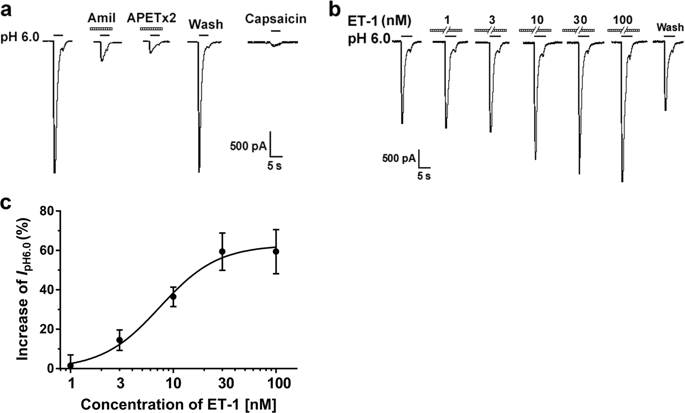当前位置:
X-MOL 学术
›
Acta Pharmacol. Sin.
›
论文详情
Our official English website, www.x-mol.net, welcomes your
feedback! (Note: you will need to create a separate account there.)
Endothelin-1 enhances acid-sensing ion channel currents in rat primary sensory neurons.
Acta Pharmacologica Sinica ( IF 6.9 ) Pub Date : 2020-02-27 , DOI: 10.1038/s41401-019-0348-z Lei Wu 1, 2 , Ting-Ting Liu 1 , Ying Jin 1 , Shuang Wei 1 , Chun-Yu Qiu 1, 2 , Wang-Ping Hu 1
Acta Pharmacologica Sinica ( IF 6.9 ) Pub Date : 2020-02-27 , DOI: 10.1038/s41401-019-0348-z Lei Wu 1, 2 , Ting-Ting Liu 1 , Ying Jin 1 , Shuang Wei 1 , Chun-Yu Qiu 1, 2 , Wang-Ping Hu 1
Affiliation

|
Endothelin-1 (ET-1), an endogenous vasoactive peptide, has been found to play an important role in peripheral pain signaling. Acid-sensing ion channels (ASICs) are key sensors for extracellular protons and contribute to pain caused by tissue acidosis. It remains unclear whether an interaction exists between ET-1 and ASICs in primary sensory neurons. In this study, we reported that ET-1 enhanced the activity of ASICs in rat dorsal root ganglia (DRG) neurons. In whole-cell voltage-clamp recording, ASIC currents were evoked by brief local application of pH 6.0 external solution in the presence of TRPV1 channel blocker AMG9810. Pre-application with ET-1 (1-100 nM) dose-dependently increased the proton-evoked ASIC currents with an EC50 value of 7.42 ± 0.21 nM. Pre-application with ET-1 (30 nM) shifted the concentration-response curve of proton upwards with a maximal current response increase of 61.11% ± 4.33%. We showed that ET-1 enhanced ASIC currents through endothelin-A receptor (ETAR), but not endothelin-B receptor (ETBR) in both DRG neurons and CHO cells co-expressing ASIC3 and ETAR. ET-1 enhancement was inhibited by blockade of G-protein or protein kinase C signaling. In current-clamp recording, pre-application with ET-1 (30 nM) significantly increased acid-evoked firing in rat DRG neurons. Finally, we showed that pharmacological blockade of ASICs by amiloride or APETx2 significantly alleviated ET-1-induced flinching and mechanical hyperalgesia in rats. These results suggest that ET-1 sensitizes ASICs in primary sensory neurons via ETAR and PKC signaling pathway, which may contribute to peripheral ET-1-induced nociceptive behavior in rats.
中文翻译:

内皮素-1增强大鼠初级感觉神经元中的酸敏感离子通道电流。
已发现内皮素-1(ET-1)是一种内源性血管活性肽,在外周疼痛信号传导中起重要作用。酸敏感离子通道(ASICs)是细胞外质子的关键传感器,并导致组织酸中毒引起的疼痛。尚不清楚初级感觉神经元中ET-1和ASIC之间是否存在相互作用。在这项研究中,我们报道了ET-1增强了大鼠背根神经节(DRG)神经元中ASIC的活性。在全细胞钳位电压记录中,在存在TRPV1通道阻滞剂AMG9810的情况下,通过短暂地局部应用pH 6.0外部溶液来诱发ASIC电流。预先使用ET-1(1-100 nM)剂量依赖性地增加了质子诱发的ASIC电流,EC50值为7.42±0.21 nM。预先使用ET-1(30 nM)可使质子的浓度-响应曲线向上移动,最大电流响应增加61.11%±4.33%。我们显示,ET-1通过内皮素A受体(ETAR)增强了ASIC电流,但在共表达ASIC3和ETAR的DRG神经元和CHO细胞中都没有通过内皮素B受体(ETBR)。ET-1的增强被G蛋白或蛋白激酶C信号传导的抑制所抑制。在电流钳记录中,预先施加ET-1(30 nM)会明显增加大鼠DRG神经元的酸诱发放电。最后,我们表明,阿米洛利或APETx2阻断ASIC的药理作用可显着减轻ET-1引起的退缩和机械性痛觉过敏。这些结果表明,ET-1通过ETAR和PKC信号通路使初级感觉神经元中的ASIC敏感,
更新日期:2020-02-27
中文翻译:

内皮素-1增强大鼠初级感觉神经元中的酸敏感离子通道电流。
已发现内皮素-1(ET-1)是一种内源性血管活性肽,在外周疼痛信号传导中起重要作用。酸敏感离子通道(ASICs)是细胞外质子的关键传感器,并导致组织酸中毒引起的疼痛。尚不清楚初级感觉神经元中ET-1和ASIC之间是否存在相互作用。在这项研究中,我们报道了ET-1增强了大鼠背根神经节(DRG)神经元中ASIC的活性。在全细胞钳位电压记录中,在存在TRPV1通道阻滞剂AMG9810的情况下,通过短暂地局部应用pH 6.0外部溶液来诱发ASIC电流。预先使用ET-1(1-100 nM)剂量依赖性地增加了质子诱发的ASIC电流,EC50值为7.42±0.21 nM。预先使用ET-1(30 nM)可使质子的浓度-响应曲线向上移动,最大电流响应增加61.11%±4.33%。我们显示,ET-1通过内皮素A受体(ETAR)增强了ASIC电流,但在共表达ASIC3和ETAR的DRG神经元和CHO细胞中都没有通过内皮素B受体(ETBR)。ET-1的增强被G蛋白或蛋白激酶C信号传导的抑制所抑制。在电流钳记录中,预先施加ET-1(30 nM)会明显增加大鼠DRG神经元的酸诱发放电。最后,我们表明,阿米洛利或APETx2阻断ASIC的药理作用可显着减轻ET-1引起的退缩和机械性痛觉过敏。这些结果表明,ET-1通过ETAR和PKC信号通路使初级感觉神经元中的ASIC敏感,









































 京公网安备 11010802027423号
京公网安备 11010802027423号